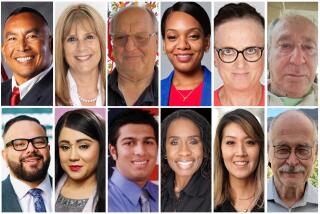Vote to Decide on Electing School Trustees by District
Voters in the San Diego Unified School District will be asked in November whether school trustees should be elected by district only and whether their number should be increased from five to seven.
An unusually divided board of trustees decided Tuesday to put the two questions on the November ballot in their first steps toward reapportioning the district.
Board members John de Beck, Susan Davis, Ann Armstrong and Shirley Weber opted to place the district-only question before voters, with colleague Sue Braun in opposition.
Candidates for the school board now run in a primary within one of five districts, with the two top voter-getters then proceeding to a citywide runoff. The proposed change would be similar to that made by voters for the City Council in 1988.
At least two members of the current board do not support a change to district-only elections because they believe trustees should represent students all over San Diego and should be judged by voters citywide.
But the four-member majority said Tuesday that voters have a right to choose the election system, especially in light of the City Council change four years ago.
Weber spoke most forcefully for the concept. “District elections have empowered communities,” she said, noting that firebrand George Stevens probably would not have been elected as her 4th District councilman without the district-only concept.
Braun said her own experience in watching City Council infighting under district elections turned her around 100% from support to opposition against even putting the concept before voters.
Armstrong, De Beck and Davis made a similar argument for allowing voters a choice in moving Tuesday to put a companion measure on the ballot to increase the number of trustees from five to seven.
Weber and Braun voted no, with Weber saying that the only compelling reason to increase the numbers would be if a greater number of districts offered a better chance for nonwhite candidates to be elected.
But preliminary redistricting scenarios drawn for the board by a private consultant show that there would probably be significant numbers of nonwhite voters in only two districts, whether the total was five or seven.
The board will decide by summer what a reapportioned system would look like using 1990 census data, both with five and seven districts. Those maps will be available to voters before the November election.
State law requires the board to stand for election under reapportioned districts by 1994.
More to Read
Sign up for Essential California
The most important California stories and recommendations in your inbox every morning.
You may occasionally receive promotional content from the Los Angeles Times.










